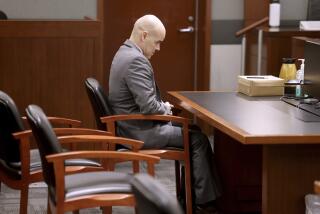Baca refuses to release records related to Times journalist Ruben Salazar’s death
Los Angeles County Sheriff Lee Baca said through a spokesman Monday that he was refusing to release eight boxes of records regarding former Times columnist and KMEX-TV News Director Ruben Salazar, who was killed by a deputy in 1970.
The Times filed a California Public Records Act request with the department in March seeking records that might shed light on the circumstances involving Salazar’s slaying, which left an open wound that has yet to heal 40 years later.
FOR THE RECORD:
Ruben Salazar records: In Tuesday’s LATExtra section, an article about L.A. County Sheriff Lee Baca’s refusal to release records sought by The Times relating to the 1970 death of journalist Ruben Salazar was accompanied by an uncredited photo of a deputy outside the Silver Dollar bar where Salazar was killed. The image should have been credited to photographer Raul Ruiz. —
Salazar had been covering a huge anti- Vietnam war rally in East Los Angeles that exploded into rioting when deputies and protesters clashed along Whittier Boulevard on Aug. 29, 1970. The newsman, who was taking a break in the Silver Dollar bar, died instantly after he was struck in the head by a tear-gas missile fired into the bar by a sheriff’s deputy.
The documents identified in response to The Times’ request include investigative reports and other files on the journalist, according to Baca spokesman Steve Whitmore.
He said Baca “has nothing to hide” regarding Salazar’s slaying but was not releasing the documents because to do so could set a bad legal precedent regarding law enforcement records that are generally confidential.
The budget-strapped department is also unable to devote personnel to review the voluminous files to determine what might be releasable, according to Whitmore. “It’s extraordinarily labor-intensive,” he said.
Other law enforcement agencies, including the FBI and the Los Angeles Police Department, have previously released records to The Times regarding Salazar.
Those documents showed that authorities monitored Salazar’s activities and reporting during his time as a foreign correspondent for The Times in Vietnam and Latin America and through his final days as a columnist and TV news director covering alleged police brutality and civil unrest in the Mexican American community on Los Angeles’ Eastside.
The records also show that an informant inside The Times passed information to the LAPD describing Salazar as a “slanted, left-wing-oriented reporter.”
All available evidence showed that Salazar’s slaying was a tragic accident. But many questions were never answered, including why the deputy used a high-velocity 10-inch projectile that the manufacturer warned was “not to be used against crowds.”
“I see no good reason why the sheriff’s office would not want to share information that might shed light on the circumstances surrounding the tragic death of Ruben Salazar,” said filmmaker Jesus Salvador Treviño, a former KCET producer who covered the 1970 rioting and the 16-day coroner’s inquest into Salazar’s slaying.
The inquest was widely criticized by Mexican American activists for focusing on the actions of the rioters instead of the circumstances surrounding what occurred at the Silver Dollar bar in the moments leading to Salazar’s killing.
“There’s just so many questions that were never resolved,” said activist Rosalio Muñoz, who organized the National Chicano Moratorium rally that exploded into rioting and who spoke with Salazar that day. “Releasing the records would give us a sounder foundation for looking at the situation.”
Parks, schools, libraries and scholarships across the country have been named in honor of Salazar. In 2008, the U.S. Postal Service issued a stamp recognizing the pioneering newsman.
More to Read
Sign up for Essential California
The most important California stories and recommendations in your inbox every morning.
You may occasionally receive promotional content from the Los Angeles Times.











